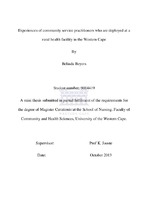| dc.description.abstract | South Africa has a general shortage of most categories of health professionals, which include nurses, doctors, dentists and pharmacists. However, the problem is exacerbated by the fact that most of these professionals either work in the private health sector or have migrated to more affluent countries. Shortages of nurses in the rural setting continue to pose a problem for the Department of Health. The community service policy is stated in Section 40 of the Nursing Act, of 2005, and in the Regulations relating to Performance of Community Service published in the Government Notice No. 765 of 24 August 2005. In 2008, the first professional nurses started with their community service. Community service for health professionals is a policy proposal of the Department of Health that reacts to the lack of meeting the health requirements in poor communities, particularly in rural areas. It offers graduating health professionals with the prospect of gaining first-hand working experience in conditions of poverty and underdevelopment. South Africa is implementing community service for health professionals as a plan to manage the difficulties of human resources in the
health sector. The transition period for community service practitioners in a rural setting is different, which implies that most support may need to be strengthened due to the remoteness of the rural setting. The purpose of this study was to describe the experiences of community service practitioners during their community service at a rural health facility. From the findings, guidelines were described for the operational managers who are responsible for supporting the community service practitioners at a health facility in a rural area. A qualitative, exploratory, and descriptive design was applied, using individual unstructured interviews and field notes. Each interview took around 30-45 minutes to complete. The purposively selected sample consisted of community service practitioners (n = 10) who were practicing at rural health facilities.
The process of inductive coding of Thomas (2003:5) was used to analyse the data.
The results of this study indicate that a process is needed for community service practitioners fresh from university and an urban environment to adapt to a remote rural health facility. Some of the participants did receive an orientation programme at the beginning of their community service year. However, most of the community service practitioners that took part in the study learned from their experience during the year of their placements. For some, the learning opportunities were more available in the rural setting than when they had worked as students at the urban hospital during their training. | en_US |

